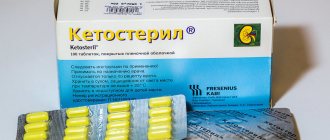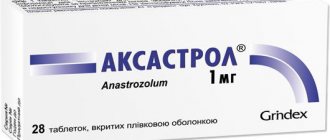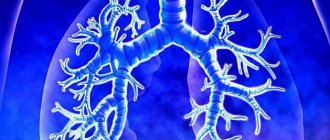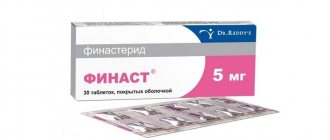Pharmacodynamics and pharmacokinetics
Pharmacodynamics
Antiarrhythmic drug. It has a membrane-stabilizing effect, sodium channel blocker properties and slight b-adrenergic blocking activity.
It inhibits the increase in action potential, which reduces the speed of impulse transmission. The refractory period in the AV node, atrium, and ventricles increases. It also lengthens the refractory period in additional conduction pathways in individuals with Wolff-Parkinson-White syndrome.
Pharmacokinetics
The drug is a mixture of S-propafenone and R-propafenone.
The highest concentration in the blood is created 2-3 hours after administration. The active substance undergoes significant biotransformation under the influence of the CYP2D6 isoenzyme . Bioavailability depends on the dose and form of release. Quickly distributed in tissues. In almost 90% of patients, the drug undergoes rapid and significant transformation, with a half-life of 3-9 hours. There are 2 main derivatives - 5-hydroxypropafenone and N-depropylpropafenone .
In another 10% of patients, the drug is metabolized more slowly. With this type of metabolism , the half-life averages 12-30 hours.
Side effects
The most common and widespread adverse reactions associated with propafenone therapy are dizziness, cardiac dysfunction, and heart palpitations.
Below are the adverse reactions that were observed in one of 885 patients who took propafenone hydrochloride with increased strength in five clinical phase I studies. And in two clinical studies, phase III. It turns out that the adverse reactions and their frequency for medicinal forms of HIV would be similar. Low-level reactions also include adverse reactions from post-marketing administration of propafenone. Adverse reactions, most commonly associated with propafenone, are based on organ systems and frequency: very often (³ 1/10), often (³ 1/100 and < 1/10), infrequently (³ 1/1000 and < 1 /100) and with an unknown frequency (adverse reactions due to post-marketing caution; the frequency cannot be determined from obvious data).
On the side are the blood and lymphatic systems.
Uncommon – thrombocytopenia; with an unknown frequency - agranulocytosis, leukopenia, granulocytopenia, anemia, hematomas, purpura, increased bleeding.
On the side of the immune system.
Uncommon – allergic reactions, positive ANA titer; with an unknown frequency - hypersensitivity (which can manifest itself as cholestasis, blood dyscrasias and viscera).
On the side of metabolism is that food.
Uncommon – decreased appetite.
On the side of the psyche.
Often - anxiety, sleep disturbance; infrequently – nightmares; with an unknown frequency - confusion of information.
On the side of the nervous system.
Very often - confusion (for example, vertigo); often – headache, dysgeusia, insomnia, drowsiness; infrequently – syncope, ataxia, paresthesia, impaired speech, depression, loss of memory, numbness, paresthesia, psychosis, mania, noise in the ears, due to an unusual smell; with unknown frequency - seizures, extraparamic symptoms, restlessness, apnea, coma.
From the side of the organs.
Often – blurred vision; infrequently - teasing the eyes.
On the side of the organs of hearing and labyrinth.
Uncommon: vertigo.
Heart on the side.
Very often - impaired cardiac conduction (including sinoatrial, atrioventricular and intraventricular block), heartbeat; often – sinus bradycardia, bradycardia, tachycardia, tripotency, angina pectoris, increased QRS interval tension, premature shortening of the sacs, swelling, intersachine blockade; infrequently - ventricular tachycardia, arrhythmia (propafenone may be associated with proarrhythmic effects, which are manifested by increased heart rate (tachycardia) or ventricular fibrillation; actions from these arrhythmias can threaten life and require resuscitation visits to control a possible fatal outcome), AV dissociation, swelling heart, tide, heat, weak sinus syndrome, sinus pause or stasis, supravular tachycardia, torsades de pointes; with an unknown frequency - ventricular fibrillation, cardiac failure (an aggravation of already existing cardiac failure may occur), decreased heart rate soon.
On the side of the ship.
Uncommon – arterial hypotension; with an unknown frequency - orthostatic hypotension.
On the side of the respiratory system, the organs of the chest and the mediastinum
.
Often - dyspnea.
On the side of the scolio-intestinal tract.
Often – abdominal pain, vomiting, nausea, diarrhea, constipation, dry mouth, loss of taste, dyspepsia, anorexia; infrequently – abdominal pain, flatulence, gastroenteritis; with an unknown frequency - cause vomiting, scolio-intestinal damage.
On the side of the hepatobiliary system.
Often - impaired liver function (this term includes elevated levels of AST, ALT, GGT and blood phosphatase); with an unknown frequency - hepatocellular disorders, cholestasis, hepatitis and diarrhea.
On the side of the skin and under the skin.
Infrequently - kropivyanka, sverbizh, visipannya, blackened skins.
On the side of the skeletal-meaty and synthetic tissue.
Often – pain in the snow; infrequently – fleshy veins, fleshy weakness; with an unknown frequency - lupus-like syndrome.
Disorders of the reproductive system and milkweeds.
Uncommon – erectile dysfunction; with an unknown frequency – a change in the number of spermatozoa (this phenomenon is reversed during propafenone therapy).
On the side of the sechovid system there is a nirok.
Uncommon – nephrotic syndrome; with an unknown frequency - nirk deficiency.
The backyard is destroyed.
Often – chest pain, weakness, fatigue, fever, excessive sweating; uncommon – alopecia; increase in blood glucose level, white; with an unknown frequency – hyponatremia, impaired ADH secretion.
Contraindications
- Brugada syndrome.
- Myocardial infarction (within 3 months).
- Severe changes in the myocardium (severe bradycardia, chronic refractory heart failure with LVEF up to 35%, sinus node weakness, cardiogenic shock, AV block, intraatrial conduction disorders, distal block, arterial hypotension.
- Severe changes in water and electrolyte balance.
- Decompensated obstructive chronic pulmonary disease.
- Concomitant use of Ritonavir .
- Myasthenia gravis.
- Age less than 18 years.
- Hypersensitivity to the components of the drug.
It is recommended to use Ritmonrm with caution in cases of atrial fibrillation , organic myocardial changes, obstructive lesions of the respiratory tract, liver or kidney dysfunction, in persons with a pacemaker, elderly patients, during pregnancy or lactation .
Review of reviews from cardiologists
Reviews from cardiologists about Rhythmonorm indicate that this remedy is one of the most effective ways to combat arrhythmia and other heart rhythm pathologies.
Cardiologists say that regular use of this medication is effective in preventing arrhythmia attacks.
According to cardiologists, the quality of Rhythmonorm’s effect on the existing problem depends on the clinical situation and the individual sensitivity of the patient. Reviews about Ritmonorma also indicate that side effects are extremely rare. But at the same time, it is better to avoid taking this antiarrhythmic drug together with other drugs of this type.
Side effects
- Hematopoietic disorders: leukopenia, thrombocytopenia, agranulocytosis, granulocytopenia.
- Immune disorders : blood dyscrasia, cholestasis , skin rash.
- Metabolic disorders: decreased appetite .
- Mental disorders: nightmares, anxiety, confusion, sleep disturbances.
- Nervous disorders: headache , dizziness , taste disturbance, fainting, paresthesia , lack of coordination, extrapyramidal symptoms , convulsions, anxiety.
- Visual disturbances: blurred vision.
- Hearing disorders: vertigo.
- Circulatory disorders: cardiac conduction disorders, tachycardia , palpitations, bradycardia, atrial flutter, arrhythmia, ventricular tachycardia, marked decrease in pressure, heart failure, ventricular fibrillation, decreased number of heartbeats, orthostatic hypotension.
- Respiratory disorders: shortness .
- Digestive disorders: vomiting, abdominal pain, nausea, constipation , diarrhea , dry mouth, flatulence , bloating, retching, diseases of the digestive system, liver dysfunction, cholestasis, hepatocellular disorders, jaundice, hepatitis.
- Skin disorders: skin itching , urticaria, erythema , skin rash.
- Musculoskeletal disorders: lupus-like syndrome.
- Reproductive disorders: decreased sperm count, erectile dysfunction.
- General disorders: weakness, chest pain, fever , increased fatigue.
general information
Ritmonorm belongs to the group of antiarrhythmic drugs. Has INN (international nonproprietary name) Propafenone. It is used in the treatment of disorders of the cardiovascular system, in particular for tachyarrhythmia.
Components and their action
The composition is based on propafenone hydrochloride. Each tablet contains 150 mg of the active ingredient.
Auxiliary components:
- magnesium stearate;
- cellulose;
- croscarmellose sodium;
- corn starch;
- hypromellose;
- titanium dioxide;
- macrogoal
The drug has a membrane-stabilizing effect, acts as a sodium channel blocker, has weak adrenergic blocking activity and a negative dromotropic effect (by reducing the intensity of impulse propagation).
After taking the drug, its maximum concentration in the blood plasma is observed after three hours. When the substance propafenone enters the body, it undergoes active biotransformation, as a result of which the bioavailability of the medicinal component depends directly on the dosage of the drug. The half-life can range from two to ten hours.
Release forms and prices
The drug is available in tablet form. The cost of Ritmonorm in Moscow may differ, depending on which pharmacy you purchase it from. Prices for the drug in Moscow pharmacies are presented in the table (Table 1).
Table 1 – Average cost of Ritmonorm
| Pharmacy name, location | Number of 150 mg propafenone tablets per package, pcs. | Cost, rub. |
| "EvaFarm", m. Mayakovskaya | 50 | 508 |
| "Zhivika", metro station Rechnoy Vokzal | 50 | 494 |
| "Solnechnaya", m. Bibirevo | 50 | 494 |
| “Heart of the Capital”, metro station Shchukinskaya | 50 | 545 |
| “36.6°”, metro Profsoyuznaya | 50 | 572 |
| "Zdorov.ru", metro station Kolomenskaya | 50 | 436 |
As you can see from the table, prices in Moscow for Ritmonorm differ significantly depending on which pharmacy you buy it from. The difference in cost can reach 100 rubles.
Instructions for use Ritmonorm (Method and dosage)
The instructions for Ritmonorm prescribe taking the tablets orally, swallowing them whole (due to the bitter taste), washing them down with liquid and without chewing.
The dosage of the drug must be selected individually, based on the patient’s response and the effect obtained. It is recommended to begin therapy in a hospital, having first stopped taking all antiarrhythmic drugs (monitoring blood pressure and ECG ).
In individuals with significantly increased QRS intervals and AV block, it is recommended to reduce the dose.
For adults weighing over 70 kg, the initial dosage is 150 mg three times a day. The dosage can be increased after 3-4 days to 300 mg twice a day, and if necessary - to a maximum dosage of 300 mg three times a day.
If the patient weighs up to 70 kg, therapy should begin with low dosages of the drug. The dosage should not be increased if the duration of use of the drug does not exceed 3-4 days.
Composition of tablets
The active ingredient of this antiarrhythmic drug is propafenone hydrochloride. This substance is distinguished by membrane-stabilizing qualities and weak beta-adrenergic blocking activity. Propafenone hydrochloride is capable of blocking sodium channels. The antiarrhythmic effect of propafenone hydrochloride is achieved through membrane-stabilizing and local anesthetic effects on the muscle tissue of the heart. This substance also acts as a blocker of calcium channels and beta-adrenergic receptors.
One tablet contains 150 g of propafenone. In addition to this substance, Ritmonorm contains various auxiliary elements, including corn starch.
Overdose
Signs of overdose: deterioration of sinus node automaticity, increased PQ interval, increased QRS complex, ventricular fibrillation, ventricular tachycardia, AV block, ventricular flutter, headache, blurred vision, dizziness, tremor, paresthesia, nausea, constipation, dry mouth mucous membranes, arrest breathing, coma .
Treatment of overdose
Hemodialysis is ineffective. In addition to carrying out standard emergency measures, it is necessary to monitor and adjust the main indicators in the intensive care unit. of Isoproterenol and Dopamine are effective . Seizures are usually treated with intravenous diazepam . You may also need to be connected to a ventilator and perform chest compressions.
Analogs
The main analogue of Ritmonorm is the drug Propanorm. Propafenone is also used as an active ingredient in this medicine. Propanorm must be taken orally immediately after meals. The dosage of this drug is determined individually and can be adjusted by the attending physician. Propanorm is indicated for the treatment of:
- severe ventricular tachyarrhythmia;
- supraventicular tachyarrhythmia.
There are other analogues of Ritmonorm. These include Propafenone. This drug has a coronary dilator and antiarrhythmic effect, ensuring the refractory period of the ventricles and atria. Taking this drug significantly increases the threshold of excitability. The release form of Propafenone is tablets and ampoules of 20 ml.
Interaction
When used simultaneously with local anesthetics or other drugs that slow down the pulse or reduce myocardial contractility, increased side effects are possible.
Concomitant use with drugs metabolized by CYP2D6 may cause an increase in the concentration of these drugs in the blood .
An increase in the content of Metoprolol, Propranolol, Desipramine, Theophylline, Cyclosporine, Digoxin in the blood can be observed when taken together with Propafenone.
Drugs that inhibit the isoenzymes CYP1A2, CYP2D6, CYP3A4 may cause an increase in the concentration of Propafenone in the blood. When using Propafenone with blockers of these isoenzymes, patients should be monitored, and if necessary, the dose of the drug should be adjusted.
Combined treatment with Amiodarone and Propafenone can cause repolarization and conduction disturbances and be accompanied by a proarrhythmogenic effect. In this case, it may be necessary to adjust the dosages of both drugs.
The simultaneous use of Propafenone and Rifampicin reduces the concentration of the former in the blood and weakens its antiarrhythmic activity.
It is necessary to monitor the parameters of the coagulation system in patients simultaneously receiving indirect anticoagulants , since Propafenone stimulates the pharmacological action of this group of drugs and increases the prothrombin time.
With the simultaneous use of Propafenone and selective serotonin reuptake blockers, an increase in the concentration of the former in the blood is possible.
Indications
The drug Ritmonorm is indicated for the treatment and prevention of the following diseases:
- ventricular arrhythmias;
- paroxysmal supraventricular tachyarrhythmias;
- paroxysmal form of atrial fibrillation;
- paroxysmal circular tachycardia using the AV node or additional pathways.
The use of this drug is indicated when standard therapy is ineffective or there are contraindications for its implementation.
special instructions
Therapy should be started in a hospital setting, since there is a possibility of arrhythmogenic effects caused by the use of Ritmonorm. It is necessary that previous antiarrhythmic treatment be completed before starting new therapy within a period equal to approximately 2-4 half-lives of the drugs used. Each patient must undergo an ECG and a general clinical examination before starting therapy.
Taking propafenone can reveal the hidden course of Brugada syndrome and provoke Brugada-like changes during an ECG . After starting treatment with Ritmonorm, it is recommended to perform an ECG to exclude Brugada syndrome.
In patients with pronounced changes in the myocardium when using the drug Ritmonorm, the occurrence of serious side effects cannot be ruled out.
Dizziness, blurred vision, increased fatigue and arterial hypotension disrupt the patient’s reaction speed and impair his ability to drive. During treatment with Rytmonorm you should refrain from such activities.
Features of good stagnation
Cardiovascular system
. Propafenone, like other antiarrhythmic effects, can cause proarrhythmic effects, which may cause new ones to appear or aggravate existing ones). It is important that the patient undergoes electrocardiographic and clinical restraint before undergoing therapy with propafenone hydrochloride to determine the clinical effectiveness of treatment and the need for its continuation.
The weak negative inotropic effect of propafenone hydrochloride may be significant for patients at risk of developing heart failure.
Administration of propafenone may unmask Brugada syndrome or cause Brugada-like changes on the ECG, especially in asymptomatic manifestations of this syndrome. After starting propafenone therapy, it is necessary to perform an ECG to exclude changes that indicate Brugada syndrome.
Propafenone hydrochloride can change the threshold of stimulation and sensitivity of fluid rhythm. In patients with a history of aqueous rhythm, the function of these devices must be checked and, if necessary, reprogrammed.
There is a potential for the transition of paroxysmal atrial fibrillation in the tripotent atrium, which is accompanied by conduction blockade 2:1 or conduction 1:1 (section “Adverse reactions”).
As with other class IC antiarrhythmic agents, patients with significant organic heart disease may be less likely to develop serious adverse reactions. Propafenone hydrochloride is contraindicated for such patients (section “Contraindications”).
Propafenone increases cardiac conductivity, which can cause a dose-dependent increase in the PR interval, QRS complex, development of first- or high-stage atrioventricular block, bundle branch block, or blockage of the internal sac. information (div. section “Adverse reactions”). Thus, if a sign of increased suppression of cardiac conduction appears during an hour of treatment with propafenone, it is necessary to change the dose or modify the drug.
Blood system.
Infrequently, during the first 4–6 years of treatment with propafenone, the development of agranulocytosis, which manifested itself with symptoms such as fever, weakness, weakness, and signs of infection, was reported. In case of a decrease in the number of leukocytes in the blood or when signs of symptoms of agranulocytosis or granulocytopenia appear, treatment with propafenone must be urgently administered. The renewal of blood cells develops over the next two days after administration of the drug.
Hepatobiliary system.
Propafenone hydrochloride should be administered with caution to patients with impaired liver function. The dose should be selected under ECG control and clinical observation. Elevations in the level of liver enzymes in the blood, development of hepatitis and cholestasis were also monitored (section “Adverse reactions”). If the liver function is impaired, the drug may accumulate.
Immune system.
Over the course of an hour-long follow-up, several patients who were discontinued from propafenone were observed to have positive antinuclear antibody (ANA) titers and one type of lupus-like syndrome. For those patients who have an abnormal ANA test result or an elevated ANA titer, treatment with the drug is recommended.
Nirki.
In patients with impaired function of the drug, when standard therapeutic doses are taken, accumulation of the drug may occur; in patients with deficiency of drugs, propafenone should be administered with caution.
Reproductive system.
In some patients, during clinical evaluation, there was a change in the number of sperm equal to follicle-stimulating hormone and testosterone.
Otherwise.
Due to its beta-blocking effect, propafenone should be used with caution in the treatment of patients with obstructive respiratory diseases, such as asthma.
Suspension during pregnancy or breastfeeding.
Vaginism.
Investigations on animals did not reveal teratogenic effects.
Adequate and well-controlled monitoring of the stagnation of this medicinal product during the period of pregnancy on a daily basis, then Rytmonorm ®
should be stagnated during this period only if the potency of the stagnation exceeds є mozhlivy rizik for the fetus. It appears that propafenone hydrochloride causes a placental barrier in humans. It was observed that the concentration of propafenone in umbilical cord blood was 30% of that in maternal blood.
Lactation.
The excretion of propafenone hydrochloride in human breast milk has not been studied. It is reported that propafenone can be passed into human breast milk. For women who are breastfeeding, propafenone hydrochloride should be taken with caution.
This is due to the fluidity of the reaction during treatment with vehicles or other mechanisms.
It is necessary to be aware that in sensitive patients, when the drug is infused, there may be adverse reactions (blurred vision, confusion, weakness, postural hypotension), which may contribute to the fluidity of the reaction ї patient and destroy his structure with transport methods or other mechanisms and remove robots that require concentration respect.
Price, where to buy
The price of Ritmonorm in standard packaging in Russia is 700-1350 rubles; in Ukraine, purchasing such a drug will cost an average of 511 hryvnia.
- Online pharmacies in RussiaRussia
- Online pharmacies in UkraineUkraine
Pharmacy Dialogue
- Ritmonorm tablets 150 mg No. 50 EbbVI
RUB 476 order - Ritmonorm (tab. p.pl/vol. 150 mg No. 50) EbbVi
472 RUR order
show more
Which is better - Ritmonorm or Propanorm?
When figuring out which is better - Ritmonorm or Propanorm, it is worth turning to the reviews about these drugs again. In both drugs, the active ingredient is propafenone, which blocks sodium channels. The main difference between these drugs is the fact that Ritmonorm is produced exclusively in the form of tablets, and Propanorm is also produced in the form of a medicinal solution.
These drugs also differ in their composition. In addition to propafenone hydrochloride, Ritmonorm contains water, microcrystalline cellulose, magnesium stearate and corn starch. Propanorm additionally contains copovidone, titanium dioxide, macrogol 6000 and dimethicone emulsion containing silicon dioxide.
These tablets also differ by manufacturer. In Russia you can most often find Ritmonorm produced in Germany. The main manufacturer of Propanorm is the Czech pharmaceutical company.
Propanorm is characterized by a large number of contraindications. Therefore, this product should be used with extreme caution.






